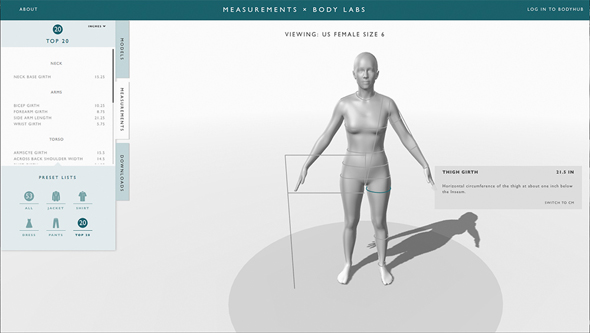Made to Measure
How one startup is making human bodies into the ultimate design platform.
Reprinted from 

Courtesy of Body Labs
The story of this startup begins with a murder.
Back in 2006, at Brown University, professor Michael Black was investigating a homicide through what’s called computer vision. The Virginia State Police had asked him to use his computer science skills to make sense of a grainy surveillance video of a suspect and his getaway car. If Black could come up with some key identifiers—like the make and model of the car, or the guy’s height—it might help detectives nab the killer.
So, on the first day of his Topics in Computer Vision course, Black tossed aside the syllabus and set his students to work cracking the case. It was a decision that would prove rather fruitful.
In the end, they did indeed help the cops. “A big drumroll moment was when the police were there on the last day of class, and we had to predict the height of the victim,” says Eric Rachlin, one of Black’s students, who recently recounted the tale to Wired. “We nailed that height, so the height of the suspect was probably a good prediction, too.” But the class had also stumbled upon research with applications far beyond the field of forensics.
In figuring out the killer’s height, they had essentially developed a way to guess, based on a few measurements, the shape of a human body. This may sound like a small thing. But Black realized that if he could develop a statistical model to predict the shape of someone’s body using a few measurements or a body scan, a world of companies could use it to cheaply and easily customize shirts, shoes, bras, sporting gear, and all sorts of other personal products.
Nearly a decade later, Black and his three co-founders have launched a startup to do just that. Called Body Labs and now backed by $2.2 million in funding, this New York City company uses Black’s statistical model of the human body to turn simple measurements and body scans into true-to-life 3-D digital avatars. Companies can use these avatars to customize products.
The trend toward personalized consumer products has been simmering for years. Today you can get earbuds custom-molded to your ear canal, buy a data-driven bra for exactly your shape, or select a button-down shirt in one of 75 sizes. But even as this mass customization movement grows, making custom products remains slow and costly. And most of these “custom” products are only semi-custom.
Now, imagine you could upload an individual’s shape with a click. Suddenly, designing that bespoke suit becomes less time-consuming. There are other possibilities, too. Hollywood could use these avatars to design more realistic effects at a fraction of the time and cost. Video game brands could let gamers upload their avatars and drop them into the game for a more immersive experience. Health and fitness apps could use it to track not just a person’s diet and weight, but the way his body physically changes over time. Using Body Labs’ technology, the body can become a platform upon which other companies can build a range of new products.
“We live in a world growing more and more customized,” says CEO Bill O’Farrell, who co-founded the company with Black and his former students Alex Weiss and Eric Rachlin. “If you believe that technology is going to allow companies and businesses to provide goods and services that are more tailored to individuals, the body is the key component around which those goods and services have to be designed and manufactured.”
The Avatars
The Body Labs avatars aren’t idealistic renderings. The system detects every lump and bump and roll. The avatars can even move through a range of positions just like you can, every wiggle and jiggle included. It recreates each body exactly as it is, and that, says O’Farrell, is what makes the technology so exciting. There are infinite applications for this, but for now, the company is starting with apparel.
Using a Body Labs avatar, designers no longer have to make a sample, fit it to a model, tailor it, fit it again, and so on. Instead, they can drop the avatar into a 3-D design program and physically see how the clothes will lay on the body. They can drape the material and see how it would move with the body. Once they get it right, the system will generate a pattern for that person.
“Custom clothing is really hard to do,” says Lawrence Lenihan, one of Body Labs’ investors, who is also chairman of the luxury clothing brand Norisol Ferrari. “I do believe this is the way you begin to size correctly and create clothes correctly. It’ll enable this new era of what we do.”
From Orthotics to Kevlar Vests
Body Labs also is working with shoe manufacturers to make more customized, comfortable orthotics. It’s working with the Army to design protective Kevlar vests for women, whose chest shapes are much more difficult to predict than those of men. It’s even working with sports apparel manufacturers to develop better protective gear for athletes. “If you’re trying to design padding for NFL running backs, they’re freaks of nature. They don’t look like anybody,” O’Farrell says. “But if we have scans of a dozen running backs, we can average those and produce a prototypical running back.”

Courtesy of Body Labs
Meanwhile, the Body Labs team is also working with other industries, from film to fitness and gaming, but O’Farrell says most of the applications for these industries won’t be created by Body Labs. The company is currently working on an API that other developers can use to integrate its bodies into their apps.
“We can’t possibly build all the good applications. We can’t even build all the bad ones,” O’Farrell says. “Our job is to provide bodies.”
The Repository
The company has a website called BodyHub where anyone can upload avatars. The goal is to turn BodyHub into a repository where people can store their avatars and send them to businesses that want to access to them. “You’ll have your account, and if you want to buy clothing, you’ll send it to your tailor. If you want your trainer to see it or your doctor, you send it to them,” O’Farrell says. “We think in the long run this is going to be a place where everyone’s body model resides.”
Whether consumers latch on to this somewhat dystopian idea remains to be seen. “It will take a while for people to get their arms around this brave new world,” Lenihan admits.
But it’s easy to see why the business world would love it, if not for the cool effects and customization it can bring to their products, then for the data it provides about their customers. Imagine Amazon tailoring its clothing recommendations to include not only what a customer might like, but what is most likely to fit well. Or perhaps, by looking at the data, a clothing manufacturer would completely overhaul its sizing to better fit its target demographic. O’Farrell wants to be the purveyor of that data.
“Our goal is to be the Google of the body. We want to organize, correlate, and make available in some statistically reliable way everything there is to know about human shape, motion, and pose,” he says. “That’s a fairly considerable undertaking, but we’ve got a good head start on it.”
More from Wired: